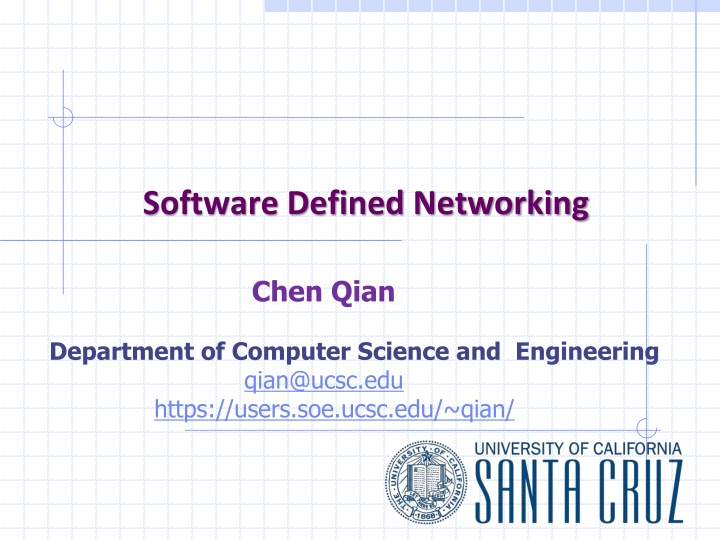
Software Defined Networking for Efficient Network Management
Discover the challenges of managing networks and how Software Defined Networking revolutionizes network operations. Explore traffic engineering difficulties and the benefits of a centralized control plane in network-layer functions.
Download Presentation

Please find below an Image/Link to download the presentation.
The content on the website is provided AS IS for your information and personal use only. It may not be sold, licensed, or shared on other websites without obtaining consent from the author. If you encounter any issues during the download, it is possible that the publisher has removed the file from their server.
You are allowed to download the files provided on this website for personal or commercial use, subject to the condition that they are used lawfully. All files are the property of their respective owners.
The content on the website is provided AS IS for your information and personal use only. It may not be sold, licensed, or shared on other websites without obtaining consent from the author.
E N D
Presentation Transcript
Software Defined Networking Chen Qian Department of Computer Science and Engineering qian@ucsc.edu https://users.soe.ucsc.edu/~qian/
Networks are Hard to Manage Operating a network is expensive More than half the cost of a network Yet, operator error causes most outages Buggy software in the equipment Routers with 20+ million lines of code Cascading failures, vulnerabilities, etc. The network is in the way Especially a problem in data centers and home networks 1-2
Traffic engineering: difficult for traditional routing 5 3 w v 5 2 u 2 1 z 3 1 2 x y 1 Q: what if network operator wants u-to-z traffic to flow along uvwz, x-to-z traffic to flow xwyz? A: need to define link weights so traffic routing algorithm computes routes accordingly (or need a new routing algorithm)! 1-3
Traffic engineering: difficult 5 3 w v 5 2 u 2 1 z 3 1 2 x y 1 Q: what if network operator wants to split u-to-z traffic along uvwz and uxyz (load balancing)? A: can t do it (or need a new routing algorithm) 1-4
Traffic engineering: difficult 5 3 v v w w 5 2 z z 2 1 u 3 1 2 x x y y 1 Q: what if w wants to route blue and red traffic differently? A: can t do it (with destination based forwarding, and LS, DV routing) 1-5
Network-layer functions Recall: two network-layer functions: forwarding: move packets from router s input to appropriate router output routing: determine route taken by packets from source to destination data plane controlplane Two approaches to structuring network control plane: per-router control (traditional) logically centralized control (software defined networking) 1-6
Traditional Computer Networks Data plane: Packet streaming Forward, filter, buffer, mark, rate-limit, and measure packets 1-7
Traditional Computer Networks Per-router control plane: Distributed algorithms Track topology changes, compute routes, install forwarding rules 1-8
Traditional Computer Networks Management plane: Human time scale Collect measurements and configure the equipment 1-9
Software Defined Networking (SDN) Logically-centralized control Smart, slow API to the data plane (e.g., OpenFlow) Dumb, fast Switches 1-10
Software defined networking (SDN) Why a logically centralized control plane? easier network management: avoid router misconfigurations, greater flexibility of traffic flows table-based forwarding allows programming routers centralized programming easier: compute tables centrally and distribute distributed programming: more difficult: compute tables as result of distributed algorithm (protocol) implemented in each and every router open (non-proprietary) implementation of control plane 1-11
SDN perspective: data plane switches Data plane switches fast, simple, commodity switches implementing generalized data-plane forwarding in hardware switch flow table computed, installed by controller API for table-based switch control (e.g., OpenFlow) defines what is controllable and what is not protocol for communicating with controller (e.g., OpenFlow) network-control applications routing load balance access control control plane northbound API SDN Controller (network operating system) southbound API data plane SDN-controlled switches 1-12
SDN perspective: SDN controller network-control applications SDN controller (network OS): maintain network state information interacts with network control applications above via northbound API interacts with network switches below via southbound API implemented as distributed system for performance, scalability, fault-tolerance, robustness routing load balance access control control plane northbound API SDN Controller (network operating system) southbound API data plane SDN-controlled switches 1-13
SDN perspective: control applications network-control apps: brains of control: implement control functions using lower-level services, API provided by SND controller unbundled: can be provided by 3rd party: distinct from routing vendor, or SDN controller network-control applications routing load balance access control control plane northbound API SDN Controller (network operating system) southbound API data plane SDN-controlled switches 1-14
OpenFlow (OF) defines the communication protocol that enables the SDN Controller to directly interact with the forwarding plane of network devices.
OpenFlow data plane abstraction flow: defined by header fields generalized forwarding: simple packet-handling rules Pattern: match values in packet header fields Actions: drop, forward, modify, matched packet or send matched packet to controller Priority: disambiguate overlapping patterns Counters: #bytes and #packets * : wildcard 1. src=1.2.*.*, dest=3.4.5.* drop 2. src = *.*.*.*, dest=3.4.*.* forward(2) 3. src=10.1.2.3, dest=*.*.*.* send to controller 1-16
OpenFlow data plane abstraction match+action: unifies different kinds of devices Router match: longest destination IP prefix action: forward out a link Switch match: destination MAC address action: forward or flood Firewall match: IP addresses and TCP/UDP port numbers action: permit or deny NAT match: IP address and port action: rewrite address and port 1-17
Examples Destination-based forwarding: Switch Port MAC src MAC dst Eth type VLAN ID IP Src IP Dst IP Prot TCP sport TCP dport Action 51.6.0.8* * * * * * * * * port6 IP datagrams destined to IP address 51.6.0.8 should be forwarded to router output port 6 Firewall: Switch Port MAC src MAC dst Eth type VLAN ID IP Src IP Dst IP Prot TCP sport TCP dport Forward * * * * * * * * * 22 drop do not forward (block) all datagrams destined to TCP port 22 Switch Port MAC src MAC dst Eth type VLAN ID IP Src IP Dst IP Prot TCP sport TCP dport Forward drop 128.119.1.1* * * * * * * * * do not forward (block) all datagrams sent by host 128.119.1.1 1-18
Edge computing (2) Taking the Edge off with Espresso Chen Qian Department of Computer Science and Engineering qian@ucsc.edu https://users.soe.ucsc.edu/~qian/
Background edge metros or points of presence (PoPs) connect Google to end users through external ISP peers 20
In tradition Peering Routers (PR) connect Google s network with other autonomous systems (AS) in the edge. These PRs support eBGP peerings, Internet-scale FIBs and IP access- control-lists to filter unwanted traffic. 22
Data plane A combination of a commodity MPLS switch (PF), and BGP speaker processes that support the traditional peering "router" capabilities. PF has a small TCAM and limited on-box BGP capability. It is capable of line rate decapsulation and forwarding of IP GRE and MPLS packets. Internet-scale FIBs are in the servers. 24
Control plane A global traffic engineering (TE) system enables application-aware routing at Internet scale. Global TE controller (GC) and location controllers (LC), programs the packet processors with flow entries Allows dynamic selection of egress port on per-application basis. 25
Global Load Balancing Purpose: Map clients to the server clusters of the CDN. Clusters assignments are made at the granularity of map units. <IP address prefix, traffic class> e.g. <1.2.3.4/24, video> Question: How to assign each map unit ??,? ? ? to a server cluster ??,? ? ? 29
improvements to user experience observed by video player 30
> 50 more frequently than with traditional peering routers. 31
Conclusion Two principal criticisms of SDN it is best suited to walled gardens that do not require interoperability at Internet scale SDN mainly targets cost reductions. This work shows that Espresso supports six times the feature velocity 75% cost-reduction many novel features and exponential capacity growth relative to traditional architectures. 32
Thank You Chen Qian cqian12@ucsc.edu cqian12@ucsc.edu https://users.soe.ucsc.edu/~qian/ https://users.soe.ucsc.edu/~qian/





